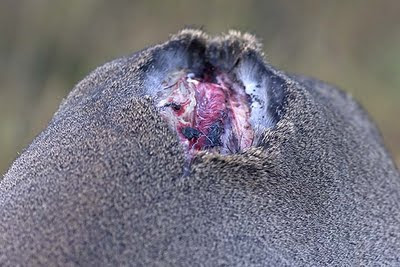 Pennsylvania Bull Elk
Pennsylvania Bull Elk
Rumors have circulated since last fall that the Elk Country Visitors center being erected at the former Betta Tree Farm on Winslow Hill was not necessarily a done deal. The 245 acre tract was acquired by The RMEF( Rocky Mountain Elk Foundation) in September of 2004. Plans were announced to construct a world class visitors center on the site with a co-operative effort between the DCNR (Department Of Conservation And Natural Resources)and the RMEF. The PGC (Pennsylvania Game Commission) was also listed as a co-operating agency, but its role in the project was downplayed, which is somewhat strange since it is the agency charged with regulating and managing the elk herd.
In 2002, Rawland "Rawley" Cogan left his position as PGC elk biologist for one with the RMEF, where he was appointed to the position of Senior Development Officer, responsible for identifying and cultivating support for RMEF projects in Pennsylvania, New York, and other New England States (PGC News Release 017-02). With the acquisition of The Betta Tree Farm, he became the driving force behind the establishment of the proposed Elk Country Viewing Center.
In 2007 if not earlier, signs were erected around the property designating it as a Wildlife Habitat Conservation Project. Entry was prohibited. Many members took exception to this as they felt that since the funds to purchase the property came at least to a certain extent from their membership dues and donations, that they should be allowed access to the area.
 Restricted Sign 2007
Restricted Sign 2007
Rightly or wrongly many perceived that Rawley Cogan was personally responsible for restricting access to the property. In at least once instance, irate RMEF members approached Cogan about this. He sympathized with their concerns, but asked them to bear with him until the visitor's center was complete and there would be a strong likelihood that they would be permitted to serve as volunteer interpreters at the viewing blinds, which were to be located at strategic points about the property. They could then combine elk viewing with performing official duties.
There was and is a strong perception that the restrictions were made without the approval of "Missoula". (The location of RMEF National Headquarters) It is my understanding that numerous complaints were made to the leadership, both by phone and letter regarding this situation.
I arrived in Elk County on September 20th, to find the grapevine buzzing with the rumor that the RMEF had turned its share of the property over to DCNR. This proved to be the case as the RMEF posted an
article on their website on Sept. 15, 2009, which corroborated that portion of the rumor. Mr. Cogan allegedly resigned from the RMEF shortly after the organization announced its withdrawal from the project.
There seems to be at least two different interpretations of the situation. One of course is that Mr. Cogan pursued a course that was not sanctioned by the national leadership of the RMEF and that they abruptly washed their hands of him and the entire matter. Mr. Cogan's supporters seem to view the situation as a personal feud between him and the national leadership.
 No Trespassing
No Trespassing Liability Protection?
Liability Protection?
No trespassing signs were recently posted by the new driveway that is under construction. Some felt this was the "straw that broke the camel's back" so as to speak, and brought on the withdrawal of the RMEF. Others pointed out that this could be solely for liability reasons, so as to prevent persons from being injured in the construction area.
Whatever the case, there were a lot of unhappy RMEF members on Winslow Hill during the past few weeks with talk of chapters disbanding or persons dropping their membership in the RMEF, etc.
Are these perceptions accurate or not? I do not know, but even if a perception is inaccurate, if enough people believe it to be true the results are often the same as though the perception is true. e.g. (If someone points an empty gun at you as a joke-admittedly a poor joke-and you are armed and fire at them, the end result is the same as though they actually intended to make an attempt on your life).
For a more detailed account of the transfer, read this edition of "
Resource", which is a newsletter published by DCNR.












